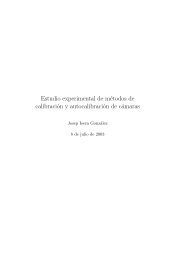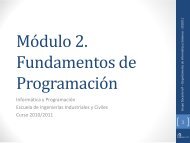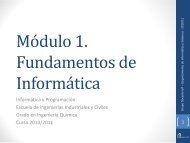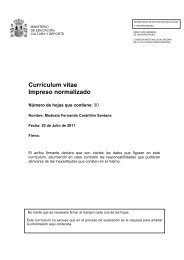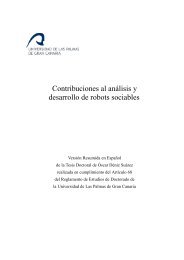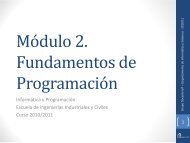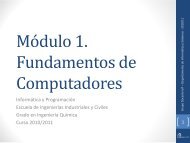PhD Document - Universidad de Las Palmas de Gran Canaria
PhD Document - Universidad de Las Palmas de Gran Canaria
PhD Document - Universidad de Las Palmas de Gran Canaria
Create successful ePaper yourself
Turn your PDF publications into a flip-book with our unique Google optimized e-Paper software.
4.4 Design for the mouth. . . . . . . . . . . . . . . . . . . . . . . . . . . . . . 50<br />
4.5 Design for the ears. . . . . . . . . . . . . . . . . . . . . . . . . . . . . . . 50<br />
4.6 Wireframe <strong>de</strong>sign of the head. . . . . . . . . . . . . . . . . . . . . . . . . 51<br />
4.7 Tilting carousel used as a neck. Courtesy of Rhino Robotics Ltd. . . . . . . 51<br />
4.8 Omnidirectional camera. . . . . . . . . . . . . . . . . . . . . . . . . . . . 52<br />
5.1 Typical omnidirectional vision setup. . . . . . . . . . . . . . . . . . . . . . 57<br />
5.2 Approximate distance measure taken with the omnidirectional camera. In<br />
this situation, a person was getting closer to the robot, from a distance of<br />
260cm to 60cm. . . . . . . . . . . . . . . . . . . . . . . . . . . . . . . . . 58<br />
5.3 Example of how an object enters the background mo<strong>de</strong>l. . . . . . . . . . . 59<br />
5.4 Omnidirectional vision module. . . . . . . . . . . . . . . . . . . . . . . . 60<br />
5.5 a) Ml does not fall in the initial or final "dangerous" zones, b) Ml falls in<br />
the "dangerous" zone, c) both Ml and Mr fall in "dangerous" zones. In the<br />
last case the sample is discar<strong>de</strong>d. . . . . . . . . . . . . . . . . . . . . . . 63<br />
5.6 Effect of changes in the intensity of the sound signal. The sound source (a<br />
mobile phone) is located on the left si<strong>de</strong> of the head at a constant distance.<br />
On the left: mean values obtained for cue 1. On the right: mean values<br />
obtained for cue 4. The upper and lower lines are the mean values plus and<br />
minus one standard <strong>de</strong>viation. . . . . . . . . . . . . . . . . . . . . . . . . 64<br />
5.7 Effect of changes in the distance of the sound source. The sound source (a<br />
mobile phone) is located at distances such that Di>Di-1. The sound intensity<br />
is constant. On the left: mean values obtained for cue 1. On the right: mean<br />
values obtained for cue 4. The upper and lower lines are the mean values<br />
plus and minus one standard <strong>de</strong>viation. . . . . . . . . . . . . . . . . . . . . 65<br />
5.8 Steps performed by the <strong>de</strong>veloped sound localization module. The work<br />
<strong>de</strong>scribed in this section focuses on the cue extraction stage. . . . . . . . . 67<br />
5.9 Plastic head used in the experiments, next to the sound card external rack<br />
and preamplifiers. . . . . . . . . . . . . . . . . . . . . . . . . . . . . . . 68<br />
5.10 Sounds used in the experiments: a) mobile phone, b) hand claps, c) maraca,<br />
d) whistling. . . . . . . . . . . . . . . . . . . . . . . . . . . . . . . . . . . 69<br />
5.11 Mo<strong>de</strong>l of attention. The feature maps must represent the same physical space<br />
than the activation map. If sensors do not provi<strong>de</strong> such values, a mapping<br />
would have to be done. . . . . . . . . . . . . . . . . . . . . . . . . . . . . 74<br />
5.12 State of the feature and activation maps. On the left column the figures show<br />
the visual and auditive feature maps. On the right column the figures show<br />
the resultant saliency map. . . . . . . . . . . . . . . . . . . . . . . . . . . 77



